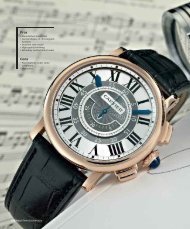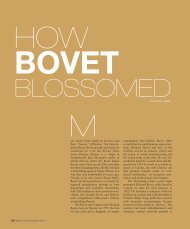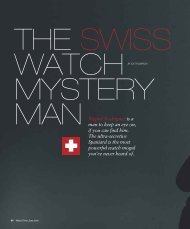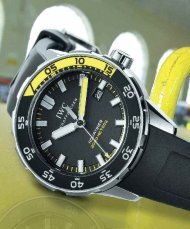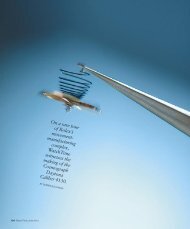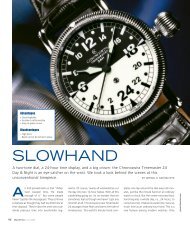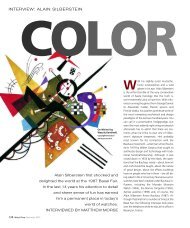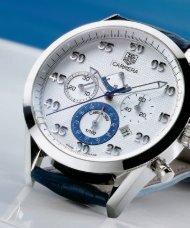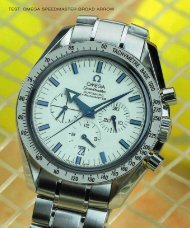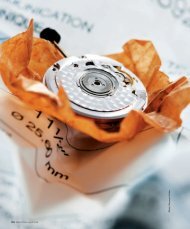You also want an ePaper? Increase the reach of your titles
YUMPU automatically turns print PDFs into web optimized ePapers that Google loves.
<strong>TEST</strong>: <strong>IWC</strong> <strong>BIG</strong> PILOT’S <strong>WATCH</strong>The BigDaddyAt 46 millimeters in diameter, 15.8 millimeters tall, andweighing in at 150 grams, the new high flyer from <strong>IWC</strong> isjust about the biggest of the big watches on today’smarket. ALEXANDER LINZ had the opportunity to conductthe first test of The Big Pilot’s Watch from <strong>IWC</strong>.66 WatchTime December <strong>2002</strong>
A new sensation inthe watch world:The Big Pilot’sWatch from <strong>IWC</strong>.December <strong>2002</strong> WatchTime 67
<strong>TEST</strong>: <strong>IWC</strong> <strong>BIG</strong> PILOT’S <strong>WATCH</strong><strong>IWC</strong> has come up with another technicallyinteresting and distinctively different watchto add to its impressive lineup. Allow us torefresh your memory: Recent newcomers includethe Deep One diver’s watch with its builtinbathymeter (depth gauge) and the new Portuguese2000 with its big, <strong>IWC</strong>-made, manufactureCaliber 5000 for seven days of powerreserve. This year’s debutante is “Die GrosseFliegeruhr,“ or The Big Pilot’s Watch, whichbears reference number 5002. If you get achance to see one of these timepieces in all itsgrand dimensions, you’ll wonder if you can indeedstrap it to your wrist. Its diameter, thickness,and weight give this behemoth the dimensionsof a solidly crafted pocket-watchrather than a modern wristwatch. However,thanks to companies like <strong>IWC</strong> and Panerai,ideals of beauty in the watch world have shiftedin recent years towards bigger wristwatches,so once you get over your first impressionthat the watch is too damn largeyou’ll start to admire its beauty.Once you strap it on, all doubtsabout its dimensions vanish withouta trace. A gentle forwardswing of the forearm, a returnswing backwards, just to be surethat this large watch will fit underyour shirt cuff, and before youknow it, you feel as though youand The Big Pilot’s Watch havebeen friends for years.The direct ancestor on whichthe newcomer from Schaffhausen, Switzerlandis patterned is the legendary Caliber 52 s. c.(s.c. stands for seconde au centre, i.e. centrallyaxial “sweep” seconds-hand), which datesfrom 1940. Commissioned by the German andBritish admiralties, <strong>IWC</strong> designed this caliber tomeet the needs of navigators at sea and in theair. Only 1,200 Caliber 52 s.c. movements wereYou’ll find yourselflamenting theefficiency withwhich The Big Pilot’sWatch windsitself, as manuallywinding it is asensual pleasure.built, approximately 1,000 aslarge-format pilot’s watches andthe remaining 200 as pocketwatchesfor use as deck watches.Constructed to satisfy the strictmilitary criteria, these navigator’swatches (so-called “B watches,class 1”) were individually testedat the German naval observatory.A genuine innovation in thosedays was the soft iron inner casethat protected the movementagainst the ill effects of excessivemagnetism in the cockpits of fighter planes andother military aircraft, a requirement specifiedby the military procurements offices on bothsides of the English Channel. Collectors may beinterested to learn that alongside <strong>IWC</strong>, similarlylarge, top-quality pilot’s watches were alsobuilt during the war years by A. Lange & Söhne,Laco, Stowa, and Wempe in Hamburg.The Caliber 5011 isimmaculately craftedand beautifullydecorated. Thesecond cover, whichis part of the softiron inner case, isreadily visible.68 WatchTime December <strong>2002</strong>
<strong>TEST</strong>: <strong>IWC</strong> <strong>BIG</strong> PILOT’S <strong>WATCH</strong>The Big Pilot’sWatch is thebrainchild ofPius Brida (left)and KilianEisenegger.The large, distinctively designed dial ishighly legible thanks to its generously proportioneddisplays and the antireflectivetreatment that’s been given to both the innerand outer surface of the sapphire crystal.The ancestor of The Big Pilot’s Watch:the Caliber 52 s. c. from 1940.We were curious to find outwhat impelled <strong>IWC</strong> to create anew watch in the spirit of thebig pilot’s watches of yesteryear.Here’s what Pius Brida, directorof product development at <strong>IWC</strong>,said in answer to our query:“The Caliber 5000, which we presented twoyears ago inside our limited-edition Portuguese2000, was only the kickoff. From thevery beginning, it had been clear to us that wewouldn’t construct a self-winding movementfor use solely inside one Portuguese model,but that we would use it as the inner life for awhole family of big watches. During the initialphases of the design process, we had alreadygiven the base caliber everything it would needso that it would be able to power many otherkinds of watches in the future.” Brida continues:“Strictly speaking, we’re the only manufacturerthat can feasibly build such a largewatch with ultramodern technology.“ Lookingback at the recent history of pilot’s watchesfrom <strong>IWC</strong>, you can see that the only thing thatwas lacking was a worthy successor to the bygoneCaliber 52 s. c. If <strong>IWC</strong> had added The BigPilot’s Watch to its collection at an earlier date,it would have had no other option but to encaseinside it either a pocket-watch movementof <strong>IWC</strong>’s own making or the big ETA Caliber6497/6498. If you ask us, <strong>IWC</strong> was wise towait until it had developed a commensuratecaliber of its own. This way, aficionados andcollectors who acquire The Big Pilot’s WatchAn inner case made ofsoft iron protectsthe movement againstmagnetism.are buying a genuine manufactureitem.The Big Pilot’s Watch pays attentionto even the smallest details.Its new Caliber 5011 improveson the 5000 by adding adate display and shifting theseconds indicator to the center of the dial. Asmall change was also made in the rotor of theautomatic winding system: the golden insigniathat adorned the rotor and was visible throughthe transparent back of the limited-editionPortuguese 2000 has been eliminated fromthe rotor of the 5011. Kilian Eisenegger, headof development at <strong>IWC</strong>, explained to us thatcomprehensive aging and stress tests havebeen conducted on the caliber ever since itsproduction first began. The total ordeal consistsof 30 steps that we were originally askednot to divulge. After lengthy negotiations withhead of development Eisenegger, we wereable to persuade him to permit us to describe asmall selection of the more interesting tests.Not every caliber in the production run is subjectedto this elaborate procedure; instead, theengineers orient themselves according to thenumber of units produced and test a preciselypredefined number of movements in order tobe sure that no substandard items slipthrough.The following tests, as well as others notmentioned here, are conducted on watchesthat have first been artificially aged, then subjectedto impact testing.70 WatchTime December <strong>2002</strong>
<strong>TEST</strong>: <strong>IWC</strong> <strong>BIG</strong> PILOT’S <strong>WATCH</strong>Hard at work in the Caliber 5011’sfinal assembly atelier, watchmakerJulia Viecenz scrutinizes the Nivarox 1balance-spring with its characteristicBreguet curvature.1. Stress from extremely strong magneticfields (> 4.8 kA/m)2. Low temperatures (48 hours at 0° C.)3. Thermal cycles (168 hours in cycles of 4hours each, heating to 50° C. and coolingto 0° C. in each cycle)4. Temperature test at high humidity (96 hoursat 50° C. and 90% humidity)5. Temperature test in extremely dry air (48hours at 50° C.)6. Variable extreme temperature tests (10repetitions in cycles of 1 hour each, heatingto 50° C. and cooling to 0° C. in each cycle;24 hours in cycles of 4 hours each, heatingto 60° C. and cooling to -10° in each cycle;24 hours in cycles of 4 hours each, heatingto 70° C. and cooling to -20° in each cycle)7. Plastic and dial test under ultraviolet light(120 hours)8. Water-resistance test submerged in saltwater(72 hours)9. Artificial aging with moderate blows (blowsgenerated by a Cyclotest device at roomtemperature during a 72-hour time period;the watch is kept inside a box, within whichit has 1 to 2 cm of play)10. Extreme shock test (strong blows generatedby a device at room temperature during a16-hour period; the watch is kept inside abox, within which it has 10 to 12 cm of play)11. Shock test NIHS 91-10, 91-20 with 5 kilograms(standardized shock test with a pendulumhaving at its lower end a 5-kilogramweight which swings through a 90° arc andstrikes directly against a particular locationon the watch. The shock generated in thistest corresponds to the impact suffered bythe watch after an uninterrupted fall onto astone floor from a height of ca. 1.5 meters.)72 WatchTime December <strong>2002</strong>
<strong>TEST</strong>: <strong>IWC</strong> <strong>BIG</strong> PILOT’S <strong>WATCH</strong>Advantages+ Perfect quality+ Interesting manufacture caliber+ Unusually large sizeDisadvantages- High price- The date jumps to the next digitone minute before midnightDATA PAGEThe Big Pilot’s Watch from <strong>IWC</strong>Manufacturer: <strong>IWC</strong> International Watch Co.AG,Baumgartenstrasse 15, CH-8201 Schaffhausen.Model: The Big Pilot’s Watch.Reference number: 5002Functions: Automatic movement with one barrel,power-reserve display, date display, hours,minutes, and centrally axial “sweep” secondshand.The movement is mechanically haltedafter 168 hours (7 days).Movement: <strong>IWC</strong> Caliber 5011; 38.2 x 7.44 mm;334 components; 53 construction groups; 44jewels; Incabloc shock absorption; rapid adjustmentfor the date display; stop-seconds function.Gear train: 57 meshing wheels (special feature:fourth-wheel beneath the escape wheel). An additional(eight-day) wheel gives this movementmore wheels than are present in a conventionalgear train; indirect large seconds and indirectminutes (both pinions are propelled outside thedirect flow of energy through the train).Barrel: Drum made of aluminum-S-Korofestal(AlMgSi1), warm-hardened, anodized, thetoothing is separately screwed on, mainspringwith bridle made of Nivaflex 1, barrel/minutewheelratio = 1 to 15; after having been fullywound, the barrel will completes ca. 13.6 revolutions;one revolution of the barrel = 15 hoursof power reserve; theoretical power reserve= 13.6 x 15 hours = 204 hours (8.5 days);ca. 12 rotations of the oscillating weight = 1hour of power reserve.Power-reserve display: Differential train withentries for winding and running, plus exit for thepower-reserve display; the movement is mechanicallyhalted after 168 hours (7 days).Winding: Pellaton click-winding system,identical with the system used in the <strong>IWC</strong>Caliber 8541 via sprung-borne rotor, cam, rubyrollers, and two pawls on the winding-wheel;step-down ratio = 175 to 1.Escapement: Two-arm screw balance with 16weight screws and two regulating eccentrics onthe arms of the balance (an <strong>IWC</strong> specialty); feuillede sauge (sage leaf or bird’s tongue) arm shape.Balance, lever, and escape wheel are identicalwith the ones used in the <strong>IWC</strong> Caliber 89. Nivarox1 balance-spring with Breguet curvature.“Chronometer” quality. 18,000 v/h = 2.5 hertz.Fine adjustment: Stud-bearer and tail ofregulator are adjusted via an eccentric (identicalwith the construction used in the <strong>IWC</strong> Caliber8541).Date: Conventional, jump-type, datedisplay (switching process requires ca. 1 hour);rapid forward adjustment via the crown;last manual date adjustment possible beforemovement exhausts its power reserve after168 hours.Decoration: Bridges and movement plate arenickel-plated; engravings are gold-plated;côtes circulaires decoration; oscillating weighthas <strong>IWC</strong>’s typical “Probus Scafusia“ engraving;sun pattern on edge of movement plate,crown-wheels, ratchet-wheel, cover of barrel,and differential wheel.Case: Stainless steel with screw-in back, sapphirecrystal is antireflective on both its faces; soft ironinner case (dial, movement-holder ring, and innerback) protects the movement against ill effectsof magnetic fields; screwed crown; watertightto 60 meters. Matte black dial with Arabicnumerals, white indices, noctilucent, coveredwith Superluminova C1. Hands crafted in originalarrow shape as was used in 1940 on the first“Big Pilot’s Watch,“ skeletonized, filled with SuperluminovaC1.Wristband and clasp: Buffalo leather, darkbrown, with rivets like those used in 1940 onthe first “Big Pilot’s Watch.“ Folding clasp withsecure button-type closure.Recommended service interval: 5 years.Results of running test: (deviations inseconds per 24 hours when fully wound)Dial up: 0Dial down: 0Crown left: +1Crown up: +2Crown down: 0Greatest deviation of rate: +2Average deviation: +1Average amplitude: 291°Dimension: Diameter = 46 mm; height = 15.8mm; weight = 150 grams.Special feature: The platinum version islimited to 500 specimens.Price: $9,900. $35,900 for platinum version.74 WatchTime December <strong>2002</strong>
<strong>TEST</strong>: <strong>IWC</strong> <strong>BIG</strong> PILOT’S <strong>WATCH</strong>Georges Kerntook the reins at <strong>IWC</strong>in early <strong>2002</strong>.The above list isn’t complete, but evenwithout explicitly mentioning the other torturesto which <strong>IWC</strong>’s testers subject theirwatches, you can be quite sure that these peopleare very serious indeed about ensuring thestamina and reliability of the Calibers 5000and 5011. The testing procedure, which isquantified on a 30-point scale, was also usedlast year to verify the sturdiness ofthe new GST Chronograph Rattrapanteand Perpetual Calendarmodels.Under Kilian Eisenegger’s direction,<strong>IWC</strong>’s technicians mathematicallycalculated the Caliber5000 last year. The gear train andthe winding mechanism were reexaminedand quantified. The results are noteworthyand they confirm the high quality of thework that former director Kurt Klaus and his designengineers performed. Eisenegger explains:“With regard to its degree of efficiency, its expectedrate of wear, and the dimensioning ofits components, this caliber performs very closeto the optimum. Our recalculations were madepossible by continual improvements in CADprograms and by the faster computers that areThe new caliberis modeledafter the legendaryCaliber 52 s. c.from the 1940s.now finally available to us here in Schaffhausen.Not so very long ago, a supercomputer wouldhave been needed to do these elaborate calculations.“We’d like to add that, in order to beabsolutely sure that no errors had been made,<strong>IWC</strong> also sent the movement to an independentand respected Swiss simulations specialist.That specialist’s number crunching yielded thesame satisfying results as <strong>IWC</strong>’s research.Elaborately constructed cases have alwaysdistinguished the family of <strong>IWC</strong>’s pilot’s watches.A soft iron inner case protects each movementfrom magnetic influences. An independentinstitute confirmed the effectiveness ofthis protection, which it quantified up to32,000 A/m without functional loss. By way ofcomparison, the norm value for “ordinary” antimagneticwatches is 4,800 A/m. <strong>IWC</strong>’s pilot’swatches are also protected against sudden lossof pressure in the cabin of an aircraft. An elaborateprocess and a special plastic insulator areused when the domed sapphire crystal, whichis antireflective on both sides, is pressed intoplace in the case. If the two parts weren’t sowell joined to one another, a sudden loss ofcabin pressure would cause the crystal to jumpout of the case and possibly burst.The Big Pilot’s gigantic crown posed anotherchallenge for the design engineers. Theytried to imagine what might happen if thisheavyweight timekeeper fell crown-first onto ahard surface or if the crown were to strikeagainst a sharp corner. They wanted to be surethat none of the watch’s smallercomponents would break, evenunder extreme stress. The massivelydimensioned tube (which issoldered to the case) and theequally clever insulating system(the threads of the screwedcrown are located inside in the“dry area”) combine to guaranteethat sufficient resistance to breakage isthere if you ever happen to need it.The Big Pilot’s Watch handsome and uncommonlythick leather wristband likewise requireda new technology to prevent it from beingstiff and inflexible. The inner layer of aleather wristband is typically made either ofleather or a cardboard-like material. This fillingmakes “shoe soles” of this large size lookgood, but their level of wearing comfort is oftenabysmally low. Furthermore, extra-largewristbands often develop cracks on their uppersurface because an ordinary leather strapsimply isn’t sufficiently flexible to cope with allthe demands of life on the wrist. <strong>IWC</strong> solvedthis problem by rejecting conventional fillingmaterials and inserting a special silicon-likeplastic. Even the sprung crosspiece that affixesthe wristband to the case has been insertedthrough the silicon rather than merely beingwrapped under a thin piece of leather at theend of the wristband. The extra effort paid off:this is the thickest, supplest, and most flexibleleather wristband that we’ve ever worn.Our impression of the quality leaves nowishes unfulfilled. Everything is exactly righton this <strong>IWC</strong> watch. The craftsmanship of thehuge case is immaculate. There are no sharpedges or corners, nothing that could irritateyour skin or catch on a loose thread. Not eventhe oversized crown poses a comfort hazard.In fact, this crown fits so perfectly betweenyour fingers that you’ll find yourself lamentingthe efficiency with which The Big Pilot’s Watch<strong>TEST</strong> RESULTSWristband and claps (max. 10 points): 10Very thick but extremely soft, hand-sewn,buffalo leather wristband with folding clasp.Operation (5): 5Exact and problem-free setting; crown clicksvery neatly into its middle position.Case (10): 9Massively worked and very heavy steel case withinterested details, including a screw-in back.Design (15): 14Clear design in typical pilot’s watch look witheye-catching, diamond-shaped crown.Legibility (5): 5Good legibility of the time under all conditions.Wearing comfort (10): 8A very heavy and large wristwatch, but itnonetheless offers a good level of wearingcomfort.Movement (20): 17<strong>IWC</strong> manufacture Caliber 5011 with automaticwinding and seven-day power reserve; beautiful,robust, and uncommonly interesting from atechnical point of view.Result of running test (10): 10Slightly “plus“ in all positions; a mere onesecond “plus“ per day; very stable rate.Overall value (15): 12Very costly! But a genuine “must have“ foranyone who collects extraordinary watches. Itsresale value will probably be quite high.TOTAL: 90 points76 WatchTime December <strong>2002</strong>
<strong>TEST</strong>: <strong>IWC</strong> <strong>BIG</strong> PILOT’S <strong>WATCH</strong>winds itself, as manually winding and settingthis timepiece is a sensual pleasure. Excellentlegibility practically goes without saying onsuch a capacious dial. The time is always instantlyand correctly readable, even if the angleof incident light is problematic or darknessreigns.Now let’s return to the issue of wearingcomfort. Naturally, this is an extra-large wristwatchand a heavy one too, but after a fewdays on the wrist, you’ll soon become accustomedto its grand dimensions. How did it feelafterwards when we strapped on an ordinarywristwatch? Suffice it to say that if you don’task, we won’t tell.Michael Bernaschek, a master watchmakerand our long-term adviser, devoted his attentionthis time around to the craftsmanship ofThe case of the Big Pilot’s Watchis lovingly detailed.the movement and the interior of the case.“The Caliber 5000,“ Bernaschek says, “hassince become an old friend, although we seldomsee one in our workshop because thus farno Caliber 5000 has developed any seriousproblems. I especially like the new version witha sweep seconds-hand and a date display becauseyou can justifiably describe it as a genuineBig Date. As far as I can see from thestandpoint of the present day, it looks asthough we probably won’t see the Caliber5011 very often in our workshop either. All inall, the craftsmanship is very impressive.“All that remains for us to do now is to considerthe cost-benefit ratio. The stainless steelversion retails for $9,900 and the platinum versionsells for $35,900. Need we say that that’snot cheap? <strong>IWC</strong> has placed this watch in theupper price limit, but the aficionado who partswith the requisite cash receives a truly specialwatch in exchange. The quality and design ofThe Big Pilot’s Watch are incomparable, and itslimited-series production ensures that it will remaina very exclusive item. We certainly won’tbe the first to point out that the things in lifewhich are genuinely worth owning almost alwayshave an usually high price. But, if thatweren’t the case, then what would we lookforward to, or save our pennies for? In ourhumble opinion, the pleasure of owning thiswatch, or even contemplating future ownership,definitely makes it worth your time to putaside a few dollars every now and then.78 WatchTime December <strong>2002</strong>



